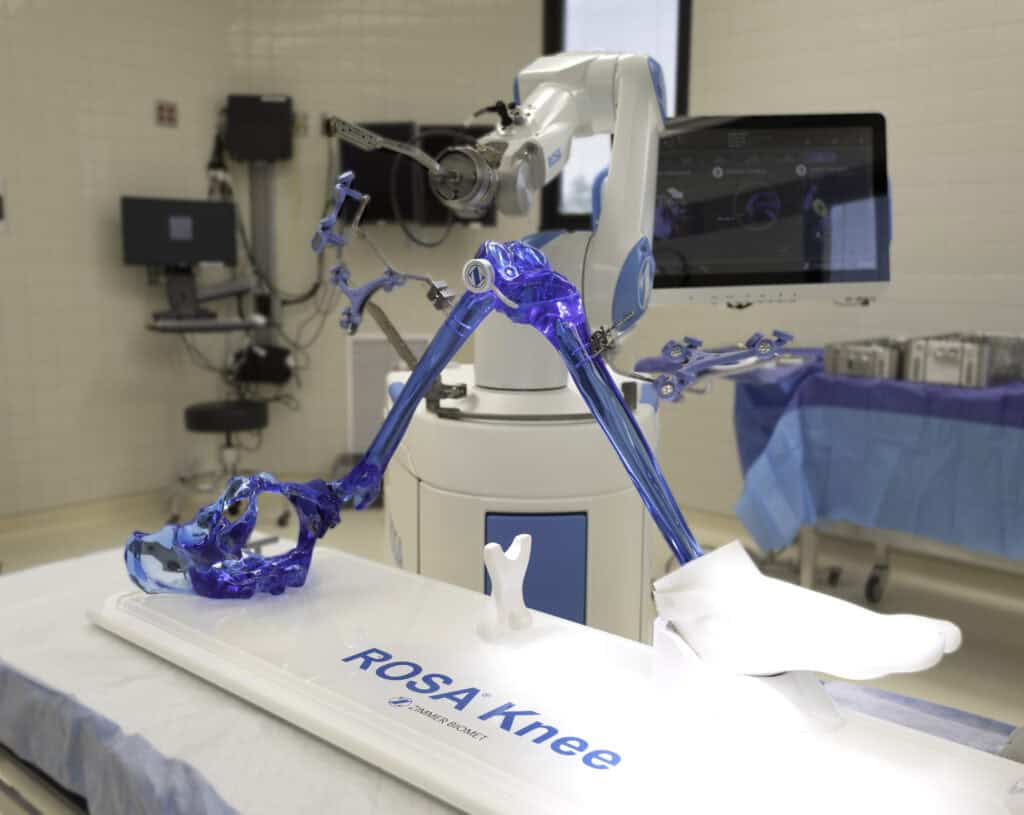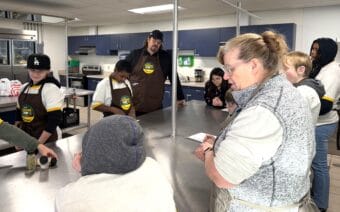
August 26, 2024
GREEN BAY – According to the American College of Rheumatology (ACR), as the American population continues to age, the demand for knee and hip replacement surgeries has also risen.
The ACR said about 790,000 total knee replacements and 544,000 hip replacements are done every year in the U.S.
To help combat the increasing numbers, Prevea Health and HSHS St. Mary’s Hospital Medical Center became the first to offer a new hip and knee replacement surgical option in the Green Bay region.
ROSA®, the Robotic Surgical Assistant, is the latest addition to the surgical technology available to Prevea orthopedic surgeons at the hospital.
Prevea Orthopedic Surgeon Thomas Florack said ROSA is designed to help surgeons tailor procedures to the specific anatomy of each patient.
“The ROSA has been around for a few years, (and can) be a useful tool,” he said.
Florack has been with Prevea for 21 years and said he has gotten increasingly involved in more hip and knee replacements.
“I also do trauma and some hand work, but a large portion of my practice is hip and knee replacements,” he said. “(Replacing hip and knee joints) has always been a high number and has been a common procedure for decades. Statistically… as the Baby Boomer population has aged, there’s been an uptick in the total number of knee and hip replacements being done in the country – it’s been a gradual process.”
Not to say other joints in the human body don’t wear out, but Florack said hips and knees are different.

“Hips and knees are weight-bearing,” he said. “There are lots of people with arthritis in their shoulders and wrists and other things, but we don’t walk on them.”
How ROSA works
Florack said traditionally, hip and knee replacements were done with a straight line in mind.
“We were taught our guide is to basically make a leg that is straight if you dropped a plumb line from the hip to the ankle, and it would go right through the middle of the knee,” he said. “That’s been the goal for 30-plus years in terms of what you’re trying to do. You want the knee to hinge back and forth but not wobble side to side – and you want to be stable throughout the range of motion.”
With the ROSA, Florack said its main purpose is to “achieve pinpoint positioning of a hip or knee implant” based on an individual’s unique anatomy.
“They started using robots several years ago, and you’re using a digital array technology to help your surgery,” he said. “The ROSA is more precise. If you’re aiming at this perfect alignment, the robot helps us avoid maybe cutting at an 85-degree angle compared to 90 degrees like you wanted.”
Additionally, Florack said, not everyone’s knee is anatomically in a straight line.
“Maybe they were born with a slightly bowed leg,” he said. “Maybe we should be trying to restore where they started rather than where we want them to be. Rather than doing ligament releases to get the balance and make it straight (the traditional way), we are modifying these by plugging your information into the computer using a visual guide and tools.”
Florack said he hopes ROSA will individualize knee replacements in the future.
“ROSA gathers and shares multiple points of data, collected before and during surgery, so we know where to precisely position the implant,” he said.
Florack said he first became interested in ROSA because with knee replacements, “unfortunately, there’s a certain number of people who are not happy with the results.”
“National studies suggest there could be a 10-20% failure rate, but I’d say it’s probably closer to 5-8%,” he said. “We keep trying to come up with ‘how can we get everybody to be happy?’”
Initially, Florack said he was a bit hesitant to use ROSA.
“I’ve been in practice at Prevea for 21 years, and before that, I was in North Carolina for 11 years,” he said. “I’ve been doing knee replacements that whole time. I’ve looked at it before and said, ‘nope.’ But then last year, in the process of looking at things again and wanting to explore better stability in all patients, I observed a high-volume surgeon in another state who was using this all the time.”
Florack said that observation changed his mind.
“The surgeon talked about what a difference ROSA has made in their patient care, and that it seems to be positive,” he said. “These are people who were doing hundreds of joint replacements a year beforehand, and now they’re seeing improved outcomes with this technology. We’re hoping we’re going to see happier people (100% of the time) – that’s what we’re looking for for our patients.”
To clarify, Florack said the ROSA does not operate on its own or move unless the surgeon prompts it to.

“The surgeon is in the operating room for the entire procedure and makes all decisions,” he said. “The ROSA simply helps in the process to make sure things are in the exact right position we need them to be – it’s based on the information we’re telling it, and we can modify that.”
Benefits of ROSA
Florack said the ROSA offers numerous benefits to patients.
“For one, ROSA individualizes a person’s knee replacement,” he said. “ROSA will hopefully improve outcomes for people, and by doing less soft tissue releases, maybe it will lead to less pain. Total knee replacements are miserable (in terms of pain) in the first few weeks. That’s the hope of this – it looks promising.”
Other positives of ROSA, Florack said, include:
- Most patients return home the same day as surgery. Most patients can drive again after two weeks and return to moderate activity after three or four weeks.
- Individuals suffering from severe osteoarthritis who have not found relief from conservative treatments can benefit from ROSA-assisted knee and hip replacements.
- People who lead active lifestyles and wish to return to their daily activities and sports benefit from faster recovery times and improved joint function.
- Older adults who may be more susceptible to complications and slower recoveries with traditional surgeries benefit from the precision and reduced invasiveness of ROSA technology.
Summing it up
Though ROSA is now available at Prevea, Florack said, the traditional way “without using the robot is still appropriate for all patients.”
“This isn’t, ‘well, gee, if you don’t have a robot, (it won’t work),’” he said. “Maybe we’ll (get there) someday – we’re still exploring. We’re hoping this is going to make a big difference. It’s a guide and a tool, but we might get in there and say, ‘I’m not going to pay attention to what the robot is telling me on this one.’ I’m sure in a few years, we’ll have a better idea.”
 The Charmant Hotel in La Crosse awarded a MICHELIN Key
The Charmant Hotel in La Crosse awarded a MICHELIN Key Driving NEW collaboration, diversity, opportunity
Driving NEW collaboration, diversity, opportunity








